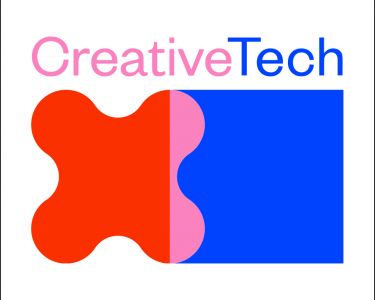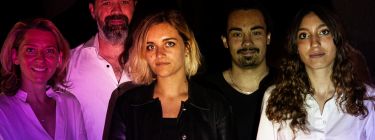
We are all Creative Tech-ers!
Laure Kaltenbach, Chairman and co-founder of CreativTech, curator and scenographer; Faustine Charles, Lydia Meignen, Paris
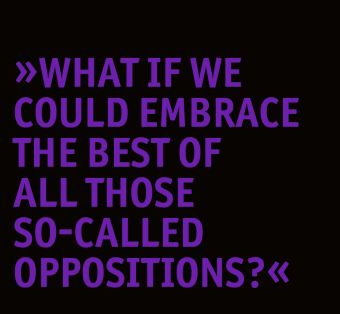
We are all Creative Tech-ers!
Why choose between artists and engineers
Chicken or egg, tea or coffee, maths or literature, music or sport, nuclear or green, left or right brain, passion or reason, artist or engineer? Do we really need to choose in every compartment of our lives? What if we could embrace the best of all those so-called oppositions?
The artist, a figure integrated into our socioeconomic models
The opportunities of the health crisis for Culture?
As in all crises, we realise the extent to which culture plays an essential, central, and apodictic role in expressing itself, through the arts, in entertaining ourselves, promoting values, creating cohesion, in giving meaning to what seems to have none. The current health crisis is no exception to the rule and new forms of creation have multiplied to experience this unprecedented time of collective global confinement. Among the encouraging examples, the creation in Italy of Special Artistic Continuity Units (Usca) by the company il Barbonaggio Teatrale with theatre on delivery—the theatre at home—was conceived in response to the prolonged closure of cultural venues. From now on, it is possible to welcome a plastic work at home, such as
“Tipping Point,” a work by Barthélemy Antoine-Lœff. If you don’t come to Lagardère, Lagardère will come to you. Simple and efficient. Beyond its crucial role for individual and collective mental health, culture is the vector of three living dynamics in our territories: it drives and increases the attractiveness of rural areas, cities and regions; it is the engine of a diversified social cohesion; and finally, it creates economic value. Culture is an economic force that is now on everyone’s lips—those of politicians, institutions, companies in the cultural and creative sectors: 2250 billion euros, or 6.1% of world GDP; 353 billion euros in exports, or 3.4% of total world trade; and 29.5 million jobs, or 1% of the world’s active population. In Europe, culture employs more than 8 million people and represents 4.4% of the territory’s GDP in 20191 (i.e. before the COVID-19 crisis). These are higher revenues than telecommunications or the pharmaceutical industry! With more than 800,000 companies, 3.2% of the companies in the European Union, the cultural sector is also a source of human exchanges: in fact, 40% of inter-European tourists travel for cultural purposes.
Culture is now integrated and considered as an asset in our economic models. However, we still need to shift the focus on the role of artists and their contribution to innovation: social, technical, technological, scientific. Lilian F. Schwartz (born in 1927) was a leading figure of innovative artists thanks to science. She is one of the first artists to join the scientific team of a laboratory and served in Bell Labs in 1968 (known particularly for having worked on the Apollo Program). There she became a pioneer in computer-assisted visual experimentation, with 2-D and 3-D animated videos, a great innovation at the time! Yet, Schwartz is presented as a visual artist and not as a contributor to technical innovations, with her works staged hermitically in events and cultural institutions.
Back to the future
Culture is a combination of different imaginary worlds that we cherish beyond our borders. The creation of Ministries of Culture (Germany in 1955, France in 1959) marked a governance based on knowledge, recognition, and the sharing of values. The first international music festival created by Richard Wagner in Bayreuth, to share culture between nationalities and generations, dates back to 1876. More recently, the European Days of Culture were established in 1991. This is a Europe of culture whose milestones reveal both a proactive political construction and an enlightened renewal of artists and their understanding of societal issues. How should creative dynamics and artists take their place in a world that integrates ecological and epidemic ultimatums? Certainly, artists have and always have had a capacity to imagine, to shift, to reveal, to leave the beaten track, to dream, to scare, to question. Certainly, we need more than ever this capacity to invent and crystallise our aspirations. Certainly, we could be satisfied with a place of the artist reserved for museums, galleries, accursed
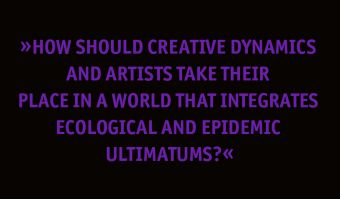
avant-garde, institutional spaces, or the oppositions between the arts from the street and those from the academic training. Of course, our time amalgamates, and everything becomes „art and culture“. Every evening we declare the death of art, and every morning it is reborn. With or without ashes.
One of the characteristics of our time is the capacity of artists to perform, to hybridise, to „hack“ techniques and technologies. An exploration that becomes polysensorial, simply listening to our senses. And it is in the search of the sense, of our senses, that the artist must create a new place and put his talents, his imaginations in the service of new social hybridisations. More and more of us are questioning ourselves, taking a step back. The artistic approach is a powerful one in a world where the link between the real and the virtual, between the physical and the digital spaces, between the material contents and the 0 and the 1 becomes more and more tenuous. The notion of a digital mirror world to ours, the umpteenth desire to live an increased polysensoriality in other spaces, materialises in the metaverse, a new Eden offering countless horizons. Let’s keep in mind the words of J.R.R. Tolkien in order „not to confuse the prisoner’s escape and the deserter’s flight“: embracing virtual worlds is in no way a flight, but a relevant anchoring to reality. To appropriate parallel digital worlds is not an ultra-modern obsession, unconscious of the stakes and dangers; it is, on the contrary, an opportunity to make those digital worlds deeply human and at the service of humans.
Artists are now producing hybrid works and exploring advanced
technologies for offbeat and sublime realisations. They also give impetus to applications that go far beyond the cultural sector. When Martin Cooper, a Motorola engineer recruited in the early 1970s, built a portable radio by trying to reproduce Captain Kirk’s “Communicator“, he invented the cell phone. The list goes on and on of other inventions, imagined by the creators of Star Trek, that have inspired companies and are now part of our daily lives: the “replicators“, ancestors of 3-D printers; the „Universal translator“ in charge of communicating beings and aliens from all galaxies, today revealed in automatic translation software, algorithms and artificial intelligence (AI); and the freehand kit of Lieutenant Uhura, the “tricorder”, which allows the user to detect and scan diseases, present today in almost all Internet of Things and wearable tech, but also giant screens, video calls, tablets, and of course PCs.
Back to the present: do you know Fragile? This installation, created by the Italian multidisciplinary studio, Fuse, explores human and organic life in its works. The installation, with evolving visual effects, is based on an algorithm that collects tweets to predict the level of stress they generate. As social networks are spaces that bring together an important part of humanity, the work gives a vision of the level of anxiety and, by (black) mirror effect, of the well-being of the actors of these networks. Among other fascinating disciplinary crossings, the TakT duo, building on the advances of neuroscience to understand our emotions, has designed an audiovisual work called „Scientific Emotions“ which deciphers our emotions through both artistic and scientific imagery.
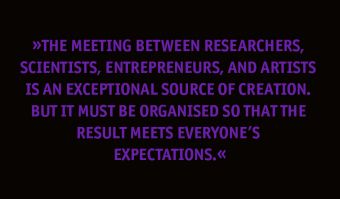
New rules of the game
This context seems to be conducive not only to the reaffirmation of the place of artists in the economic and social ecosystem, but also to the intersectoral spread of talent. The multiplicity of paths, training, decentralised learning, the possibility of combining disciplines and fields of expertise change the rules of the game. In concrete terms, encounters with artists must multiply and go beyond the cultural and creative sectors. The image of the artist as an entertainer, or even as someone who is unfit for scientific and economic rigour, is long gone. This image is not only caricatured but also light years away from the reality of an artist who, like a scientist, relies on the senses, his intuitions to create, invent, draw, compose, repeat, make mistakes, take up again, undo, redo, in a long-term iterative creation cycle. The meeting between researchers, scientists, entrepreneurs, and artists is an exceptional source of creation. But it must be organised so that the result meets everyone’s expectations. The good news? It’s an equation that works every time! On a regional, national, and European scale! Examples are coming from all over the world, at the crossroads of all knowledge: research on biomimicry, which takes nature as a starting point and inspiration, is becoming a reference: from politics to medicine, from the arts to logistics, the behaviour of organic and animal species are rich in lessons and solutions. Bulletproof vests? Born from the observation of the resistance of spider threads! The physical-chemical engineer Kalina Raskin announces that life will endure without us. From now on, she is looking for ways to make different forms of life cohabit within the framework of a responsible innovation that considers the rhythm of nature, and this, thanks to… groups of thinkers from different „worlds”. Inspiring, isn’t it?
Mixing the worlds: a winning solution for the future
Desperately (really) seeking creative co-working
Today, no one questions the crucial role of collaboration in innovation: between brands, between teams of the same company, between teams of companies from different sectors, between generations, between countries, etc. However, the holy grail has not yet been found for an implementation on a European scale that would make it possible to embody these transdisciplinary collaborations on a large scale. We remember the innovative European programs, notably Kaleidoscope (one of the first financial support programs for artistic creation and cooperation, 1996-1998) and Culture 2000 (2000-2006), with disparate effects at European level. How to make collaboration between actors and territories concrete without confusing team-building and innovation?
This European ambition needs a program with a relatively long timeframe so that fertile crossings materialise and that tomorrow, an Italian neuroscience laboratory works with Swedish designers to
create a new banking service, a Dutch dancer gives new foundations to a German algorithm to facilitate inventories in warehouses, a Slovenian AI researcher relies on a French designer to invent a new industrial co-bot, a Portuguese musician virtualises a new Belgian technology to lay the foundations of a humanised call centre, a Luxembourgish quantum physicist makes new discoveries thanks to a Finnish photographer to secure protocols… It is a strong impetus that must be given so that examples do not just multiply but become a Pavlovian reflex for innovation. Will the European Knowledge and Innovation Community (KIC) for the cultural and creative sectors make the magic possible? The stakes are high and concern all stakeholders: companies have concrete innovations for their products or services, explorations but also managerial transformations; research renews its opportunities for opening up, highlighting its skills and contributing to the attractiveness of the scientific field; artists benefit from unprecedented industrial and scientific means to create an ambitious „work-innovation“. Concrete and successful examples of this approach exist. CreativeTech has produced several in France, notably, in the Pays de la Loire region.
Culture is future
Culture au Futur© (Culture is Future) is a transdisciplinary innovation and creation project conceived by CreativeTech for the Pays de la Loire region in France. This original program allows the creation of „innovation-works“ in the framework of workshops bringing together a company, one or more researchers in a scientific field and an artist (or a collective of artists). In other words, it is a question of simultaneously mobilising the cultural, economic and scientific actors of a given territory. The result is startling. The originality lies not only in the method invented by CreativeTech but also in the place of artists in the innovation process: it is indeed the artists who give the initial impulse to the collective work. All industrial sectors, all research fields and all artistic disciplines are concerned. The “innovation-works” already produced reveal the capacity of the trinomials to jointly respond to societal issues (ecology, recycling, over-cycling, acoustic waves, future industry, economic cycles, …) and technical issues (stabilisation of pigments, data restitution, remote control by algorithm or application…).
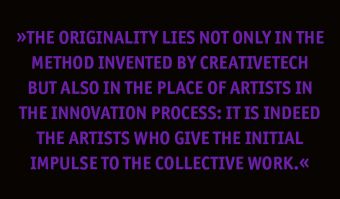
Pascal Denoël, President of the ZeKat Group, who participated in season 1 of Culture au Futur,sums up the experience as follows: „You abolish all boundaries. Everyone must create according to their technological and artistic sensibilities and within a project that has a dimension that goes beyond the company; everyone must remove their own barriers. At this point I see my collaborators differently as a leader, but they see each other differently. People talk to each other more easily and respect each other much more easily. (…) And the result is tangible: the technological innovations that were conceived together are going to be found in our products, to be marketed. And the spectacle is magnificent.“
Europe strikes back
It’s a credo that Europe is starting to put into action thanks to some truly original programs that think big in space and time. This is particularly the case with the audacious S+T+Arts program launched in 2015, where the world of technology brilliantly meets that of artists. Bringing worlds together also means bringing together nationalities and cultures. The Erasmus program embodies this brilliantly: bringing students together and benefiting from the lessons of other countries to enrich their future professional lives. The good news is that Europe is home to 23 million companies, 2 million scientists, and 1.4 million artists. What are we waiting for to make the intersection of disciplines for innovation the European trademark!
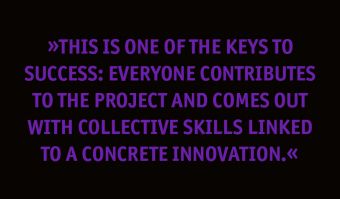
Human first! People at the heart of the transdisciplinary process
Yoga positions: Aligning humans in the centre of our path
The mantra seems „simple“: put in the same space (physical or virtual) a company, a scientist, and an artist. This collective star alignment requires a dedicated environment and a marked methodology to go beyond the often-deceptive concepts of hackathons or lightning exploration projects. It is indeed about combining mind and body, through rituals, a lot of discipline and a lot of intellectual flexibility but not only! Sonia Bergeot, planner for the Colart Fine Arts group of materials, saw the alchemy take place during the workshops of season 1 of Culture au futur: „The manipulation of products with chemists and artists awakens new inspirations for future developments of products or services for the company. That’s where the magic happens.” The credo is that each stakeholder—artist, researcher, company employee and animators-conductors of the “work-innovation”—highlights their own skills, without disguising themselves, in a spirit of curiosity. Indeed, it is a question of giving the best of one’s way of being, thinking, working, and interacting with worlds foreign to yours. This is one of the keys to success: everyone contributes to the project and comes out with collective skills linked to a concrete innovation. A great community of CreativeTechers is born.
The creation of artwork-innovation—“it's alive, alive!”
Within the framework of our interventions, we work on projects at the crossroads of innovation and creation. For example, a company making clothes for professionals had the ambition to think about tomorrow’s work clothes, by collecting data on individuals, to limit difficulties at work. A visual artist poetically re-examined the materials in order to illustrate the dynamics of the company immersed in issues of health and well-being at work. Cross-fertilisation also led us to the hacking of a Smart Guitar with the aim of completely reinventing the scenography of a show and the way in which one can remotely control the instruments on stage thanks to a virtual reality headset and a gyroscopic application. Or a textile manufacturer of more than 200 wished to re-examine the life cycle of its materials and, thanks to the crossed views of researchers in acoustics with that of an artist specialized in the fold, the company was able to upcycle these dormant stocks. The latter were transformed into powerful soundproofing sheets! What a smart collaboration…Ultimately, applying the CreativeTech’s methodology empirically means creating hybrid project methods according to the realities of the actors involved, guided by the same desire: to create a work and find an operational solution to a business problem in a “win-win” and transgenerational logic. Europe is the new playground, and with its protean resources, the possibilities are endless. Finally, some good news!
Join the CreativeTechers’ generation
The winning equation—companies x scientists x method artists x humans—is on its way to be disseminated in Europe. Our famous equation is endowed in—take note, exhibitors!—a proven method and people ready to take up challenges.
Approximately 4.2 million km2, 27 countries, nearly 90 territories with their own systems of governance, about 400 cities with more than 100,000 inhabitants, soon to be 448 million inhabitants, with Ode to Joy as its anthem—does this sound familiar? What if the result of this winning equation made it possible to create a European „overview effect“ (like the planetary overview effect described by the astronauts) that would sublimate all our creative resources in order to deploy a collective and enthusiastic vision of the future in the territories, regions, länders, provinces, and departments of all of Europe. „Arts and Crafts“ reinvented in the 21st century: easy, right?
“The history of science is not only the history of the constitution and proliferation of disciplines, but at the same time the history of the rupture of disciplinary borders, of the encroachment of a problem of one discipline on another, of the circulation of concepts, of the formation of hybrid disciplines that will end up becoming autonomous; finally, it is also the history of the formation of complexes in which different disciplines will aggregate by agglutinating themselves. In other words, if the official history of science is that of disciplinarity, another linked and inseparable history is that of inter-trans-poly-disciplinarity.” Edgar Morin2
References
1 Marc Lhermitte, Hugo Alvarez, EY, January 2021. https://www.ey.com/fr_fr/government-publi-sector/panorama-europeen-des-industries-culturelles-et-creatives-editio.
2 Edgar Morin, “La méthode”, 1981.
CreativeTech
Being: together! Born 2017, CreativeTech is a cultural engineering agency that orchestrates the meeting of artists, scientists, entrepeneurs to generate go-to-market innovations and exhibitions, both in digital and physical locations. This synergy of points of view, experiences and expertise embodies the current hybridization of profiles in all the industries. This Bigbang delivers supernova.tive makers and thinkers and constitutes the DNA of CreativeTech methodology.
Inspiring the future! CreativeTech also strives to think optimistically about the future, always integrating a responsible and conscious approach to social and environmental issues in the different territories. The aim: developing operational innovation for companies as well as institutions toward contemporary questions, such as living in the age of the blockchain and metaverse, hacking Time and Space, tapping into neuroscience to decipher the power of our emotions… to inspire all of us.
